ESP Alfa Romeo 8C 2009 Owner handbook (in English)
[x] Cancel search | Manufacturer: ALFA ROMEO, Model Year: 2009, Model line: 8C, Model: Alfa Romeo 8C 2009Pages: 223, PDF Size: 14.35 MB
Page 107 of 223
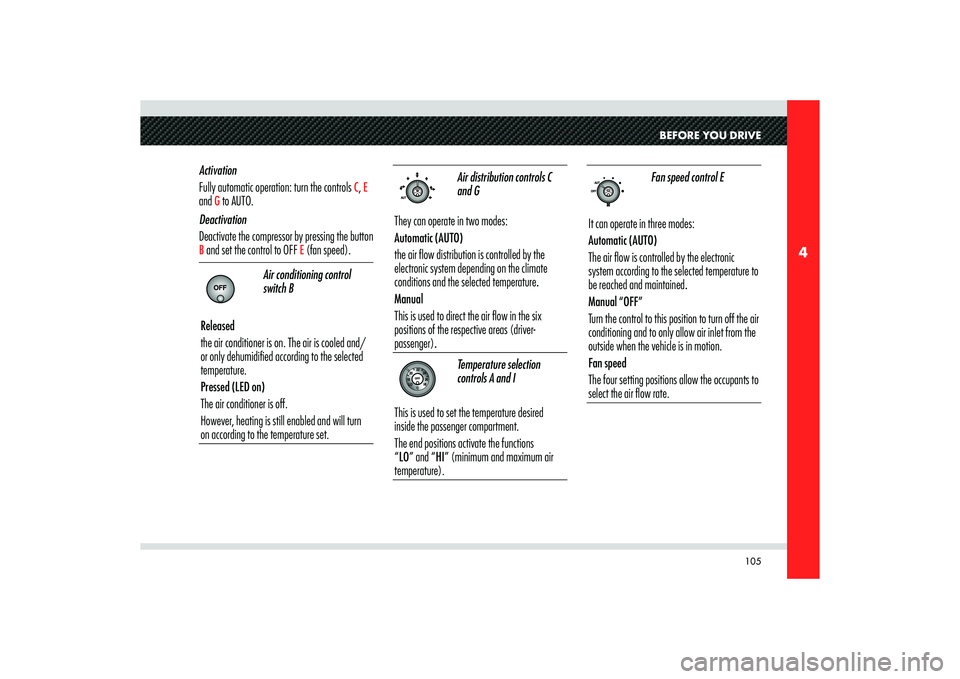
105
4
BEFORE YOU DRIVE
Air distribution controls C
and G
They can operate in two modes:
Automatic (AUTO)
the air flow distribution is controlled by the
electronic system depending on the climate
conditions and the selected temperature.
Manual
This is used to direct the air flow in the six
positions of the respective areas (driver-
passenger).
Temperature selection
controls A and I
This is used to set the temperature desired
inside the passenger compartment.
The end positions activate the functions
“LO” and “HI” (minimum and maximum air
temperature). Activation
Fully automatic operation: turn the controls
C, E
and
G to AUTO.
Deactivation
Deactivate the compressor by pressing the button
B and set the control to OFF
E (fan speed).
Air conditioning control
switch B
Released
the air conditioner is on. The air is cooled and/
or only dehumidified according to the selected
temperature.
Pressed (LED on)
The air conditioner is off.
However, heating is still enabled and will turn
on according to the temperature set.
Fan speed control E
It can operate in three modes:
Automatic (AUTO)
The air flow is controlled by the electronic
system according to the selected temperature to
be reached and maintained.
Manual “OFF”
Turn the control to this position to turn off the air
conditioning and to only allow air inlet from the
outside when the vehicle is in motion.
Fan speed
The four setting positions allow the occupants to
select the air flow rate.
Page 126 of 223

124
5
WARNING: In the event that the control lever
assembly is malfunctioning, in addition to
activating the buzzer and the failure warning
light
, the system enables “automatic
gearshift” mode and any gearshift command,
including the request for N and R, will be
ignored.
WARNING: If the malfunction persists,
contact an Authorised Service Centre of the
Manufacturer’s Network as soon as possible to
have the malfunction corrected.
PUSH START
In the case of malfunctioning of the starter
system, you can push-start the vehicle
proceeding as follows
- perform the “system start-up” stage
- request UP while the vehicle is picking up
speed with the gearbox in N.WARNING: This procedure should not be used
unless there is an emergency situation!
USING THE
BRAKESTo allow the brake pads and discs to run in
properly, avoid sudden braking during the first
300 km.
The ABS is a component of the braking system
that provides two basic advantages:
- It avoids locking of the wheels and thus
skidding during emergency braking,
especially under low grip conditions.
- It makes it possible to brake and steer at
the same time in order to avoid unexpected
obstacles or to direct the vehicle where
desired when braking: this is in keeping
with the physical limits of the tyre side grip. In order to fully exploit the ABS:
- You will note a light vibration of the brake
pedal during emergency braking or braking
under low grip conditions: This indicates
that the ABS is operating. Do not release
the pedal but continue to press it to give
continuity to the braking action.
- The ABS prevents the wheels from locking,
but it does not increase the physical grip
limits between the tyres and the road.
So, even with vehicles equipped with
ABS, always ensure that you keep to a
safe distance from the vehicle in front and
reduce your speed when entering a bend.
Page 128 of 223

126
5
Engine control system (EOBD)
The EOBD (European On Board Diagnosis)
system fitted on the vehicle is compliant with the
2003/76B/EC Directive (EURO 4).
This system continuously monitors the
components of the vehicle related to emissions;
it also indicates, when the warning light
illuminates on the instrument panel, that the
components in question are in poor condition.
The objective is the following:
- monitor the system effi ciency
- indicate when a problem causes an
increase in emissions exceeding the limits
established by European regulations
- indicate the need for replacement of worn
components.In addition, the system includes a diagnostics
connector that can be interfaced with suitable
instruments. This makes it possible to read the
error codes stored in the control unit, together
with a set of specific parameters for engine
operation diagnostics.
WARNING: If when turning the ignition key
to MARthe warning light
does not
illuminate or if it illuminates while driving,
contact an Authorised Service Centre of the
Manufacturer’s Network as soon as possible.
WARNING: After correcting the malfunction, the
entire system must be tested by the personnel
of an Authorised Service Centre of the
Manufacturer’s Network that must perform
tests on the bench and, if necessary, the road
test the vehicle: this might require travelling long
distances.
CONSTANT SPEED
REGULATOR (CRUISE CONTROL)GENERAL
The Cruise Control function allows the driver
to maintain the desired vehicle speed constant
without pressing the accelerator pedal. This
reduces driver fatigue on highways, especially
long trips, as the set speed is automatically
maintained.WARNING: The device can only be activated at
speeds exceeding 30 km/h and it deactivates
automatically when the brake pedal is
depressed.
Page 132 of 223

130
5
HEADLIGHTSBI-XENON HEADLIGHTS
The gas-discharge (Xenon) headlights use an
electric arc saturated with Xenon gas under
pressure, instead of the incandescent filament.
The light produced is markedly superior to that
of traditional light bulbs, in terms of quality
(brighter light) as well as of the span and
positioning of the area illuminated.
The advantages offered by better lighting can be
clearly perceived (less eye strain and increased
orientation for the driver and thus driving safety)
especially in the case of bad weather, fog
and/or insufficient road indications owing to the
broader illumination of the side zones, which are
normally left in the dark.The much broader illumination of the side zones
markedly increases driving safety as it allows the
driver to better detect other persons on the side
of the road (e.g. pedestrians, bicycle riders and
motorcycle drivers).
The electric arc requires very high voltage for
striking, but after activation power is supplied at
a lower voltage.
The headlights reach maximum brightness about
0.5 seconds after activation.
CAUTION
Should the bulbs need to
be replaced, have this operation
performed only at an Authorised
Service Centre of the Manufacturer’s
Network. RISK OF ELECTRICAL
SHOCKS!
DRIVING
CONDITIONSBEFORE A TRIP
Check the following at regular intervals and
always before long trips:
- tyre pressure and condition
- levels of fl uids and lubricants
- conditions of the windscreen wiper blades
- proper operation of the warning lights and
of the external lights.WARNING: It is always advisable to perform
these checks at least every 800 km and to
always follow the maintenance operations
provided for in the “Warranty and Maintenance
Schedule” book.It is also advisable to:
- clean the glass on the external lights and all
other glass surfaces
- properly adjust the mirrors, steering wheel,
seats and seat belts.
Page 134 of 223

132
5
TRAVELLING
- Caution is the fi rst rule for safe driving.
Being careful also means being in a position
to be able to predict the driving behaviour
of other drivers, that may be wrong or
careless.
- Keep a safe distance from vehicles in front
of you, adjusting this distance in accordance
to the vehicle speed and traffi c conditions.
- Strictly follow the traffi c regulations
applicable in each country and above all,
respect the speed limits.
- Long trips should be started in optimal
physical condition.
CAUTION
Drunk driving, or driving
under the influence of drugs or certain
medicines is extremely dangerous for
the driver and for others.CAUTION
Always fasten the seat belts.
Travelling without your seat belt
fastened increases the risk of serious
injury in the event of a collision.
- Make regular stops to loosen up your limbs
and refresh yourself, and avoid driving for
hours on end.
- Ensure that the air inside the passenger
compartment is changed constantly.
- Never coast downhill with the engine off:
the braking action requires greater effort on
the pedal due to the absence of the engine
brake and the power braking system. DRIVING AT NIGHT
The main guidelines to follow when driving at
night are set out below:
- Drive with the greatest caution: at night the
driving conditions are more demanding.
- Reduce your speed, especially on roads with
no street lights.
- At the fi rst signs of drowsiness, stop: to
continue driving would be a risk for yourself
and for others. Continue only after you have
had a rest.
- Keep the vehicle at a greater distance from
vehicles in front of you than you would
during the day: it is diffi cult to assess the
speed of other vehicles when you can only
see the lights.
- Make sure that the headlights are aimed
correctly: if they are too low, they reduce
visibility and strain the eyes. If they are too
high, they may bother the drivers of other
cars.
Page 137 of 223
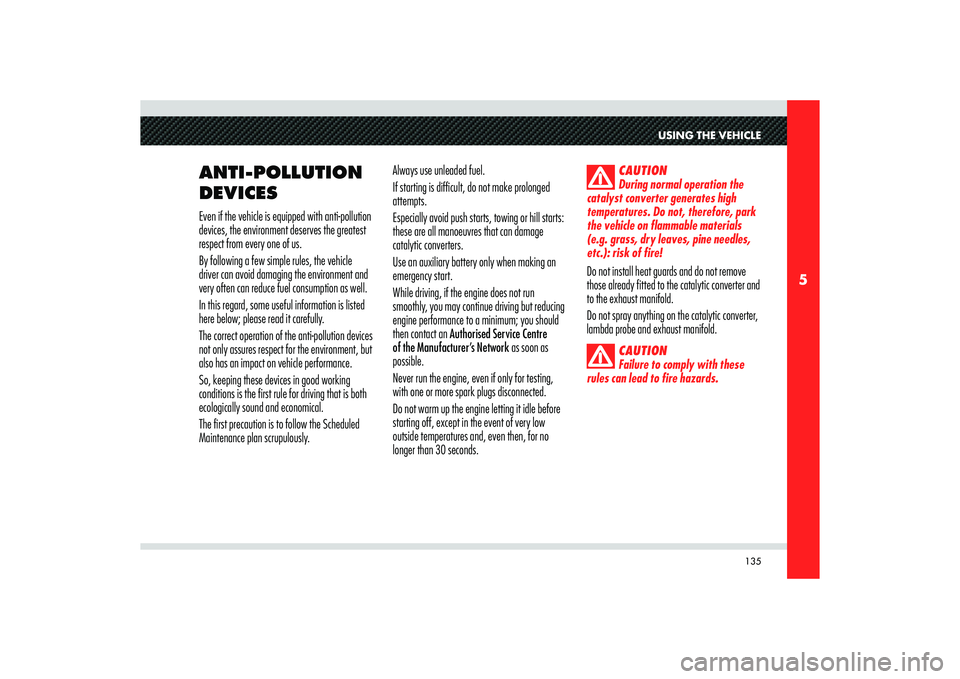
135
5
USING THE VEHICLE
ANTI-POLLUTION
DEVICES Even if the vehicle is equipped with anti-pollution
devices, the environment deserves the greatest
respect from every one of us.
By following a few simple rules, the vehicle
driver can avoid damaging the environment and
very often can reduce fuel consumption as well.
In this regard, some useful information is listed
here below; please read it carefully.
The correct operation of the anti-pollution devices
not only assures respect for the environment, but
also has an impact on vehicle performance.
So, keeping these devices in good working
conditions is the first rule for driving that is both
ecologically sound and economical.
The first precaution is to follow the Scheduled
Maintenance plan scrupulously. Always use unleaded fuel.
If starting is difficult, do not make prolonged
attempts.
Especially avoid push starts, towing or hill starts:
these are all manoeuvres that can damage
catalytic converters.
Use an auxiliary battery only when making an
emergency start.
While driving, if the engine does not run
smoothly, you may continue driving but reducing
engine performance to a minimum; you should
then contact an Authorised Service Centre
of the Manufacturer’s Network as soon as
possible.
Never run the engine, even if only for testing,
with one or more spark plugs disconnected.
Do not warm up the engine letting it idle before
starting off, except in the event of very low
outside temperatures and, even then, for no
longer than 30 seconds.
CAUTION
During normal operation the
catalyst converter generates high
temperatures. Do not, therefore, park
the vehicle on flammable materials
(e.g. grass, dry leaves, pine needles,
etc.): risk of fire!
Do not install heat guards and do not remove
those already fitted to the catalytic converter and
to the exhaust manifold.
Do not spray anything on the catalytic converter,
lambda probe and exhaust manifold.
CAUTION
Failure to comply with these
rules can lead to fire hazards.
Page 151 of 223
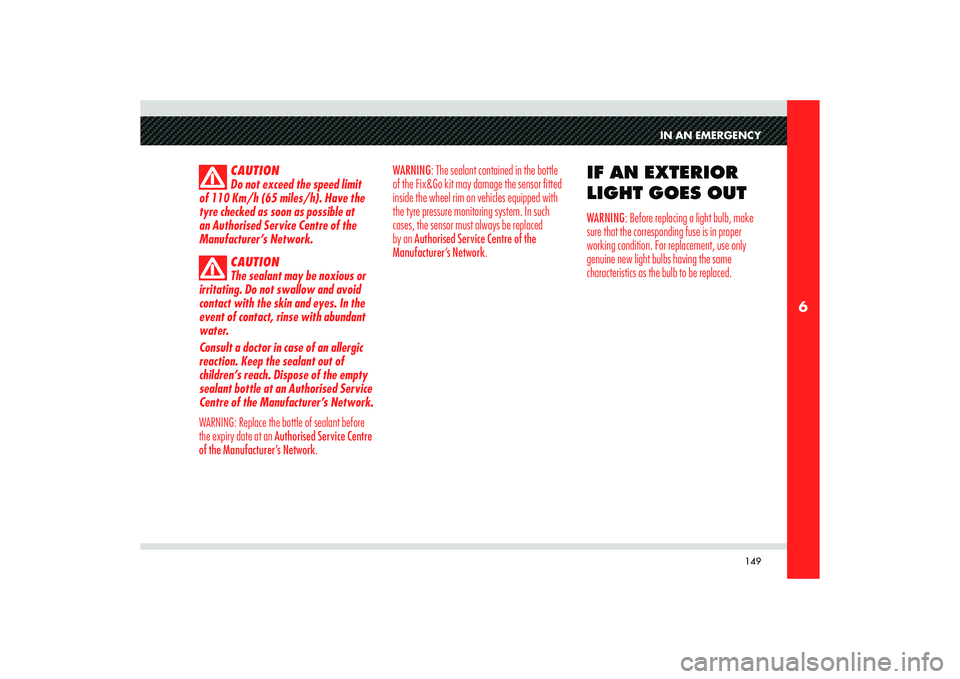
149
6
IN AN EMERGENCY
CAUTION
Do not exceed the speed limit
of 110 Km/h (65 miles/h). Have the
tyre checked as soon as possible at
an Authorised Service Centre of the
Manufacturer’s Network.
CAUTION
The sealant may be noxious or
irritating. Do not swallow and avoid
contact with the skin and eyes. In the
event of contact, rinse with abundant
water.
Consult a doctor in case of an allergic
reaction. Keep the sealant out of
children’s reach. Dispose of the empty
sealant bottle at an Authorised Service
Centre of the Manufacturer’s Network.
WARNING: Replace the bottle of sealant before
the expiry date at an Authorised Service Centre
of the Manufacturer’s Network. WARNING: The sealant contained in the bottle
of the Fix&Go kit may damage the sensor fitted
inside the wheel rim on vehicles equipped with
the tyre pressure monitoring system. In such
cases, the sensor must always be replaced
by an Authorised Service Centre of the
Manufacturer’s Network.
IF AN EXTERIOR
LIGHT GOES OUTWARNING: Before replacing a light bulb, make
sure that the corresponding fuse is in proper
working condition. For replacement, use only
genuine new light bulbs having the same
characteristics as the bulb to be replaced.
Page 155 of 223
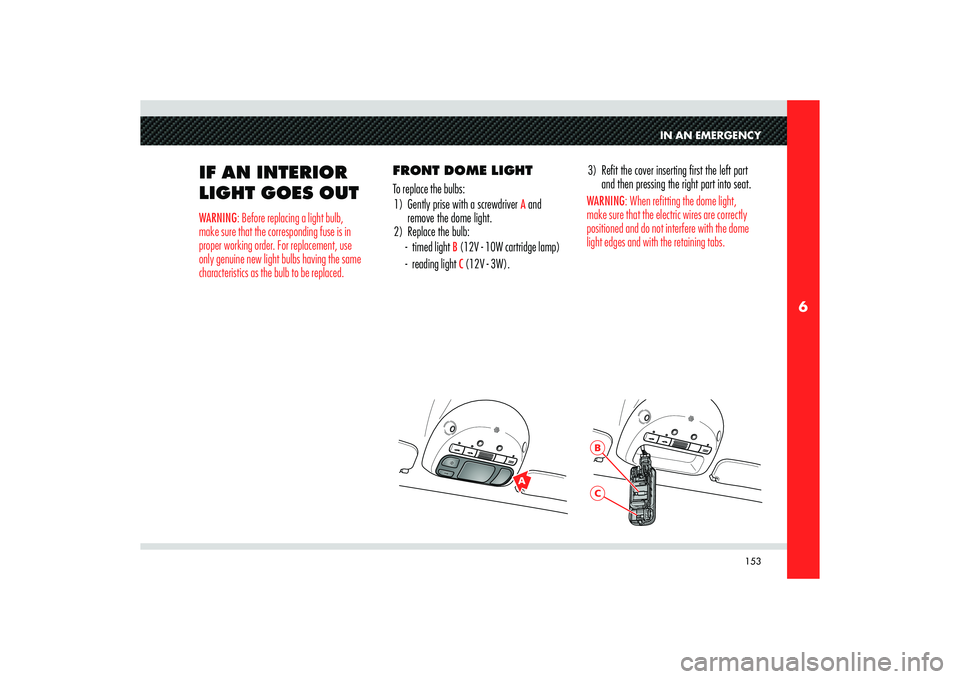
153
6
A
BC
IN AN EMERGENCY
IF AN INTERIOR
LIGHT GOES OUTWARNING: Before replacing a light bulb,
make sure that the corresponding fuse is in
proper working order. For replacement, use
only genuine new light bulbs having the same
characteristics as the bulb to be replaced.
FRONT DOME LIGHT
To replace the bulbs:
1) Gently prise with a screwdriver
A and
remove the dome light.
2) Replace the bulb:
- timed light
B (12V - 10W cartridge lamp)
- reading light C (12V - 3W).3) Refi t the cover inserting fi rst the left part
and then pressing the right part into seat.
WARNING: When refitting the dome light,
make sure that the electric wires are correctly
positioned and do not interfere with the dome
light edges and with the retaining tabs.
Page 158 of 223
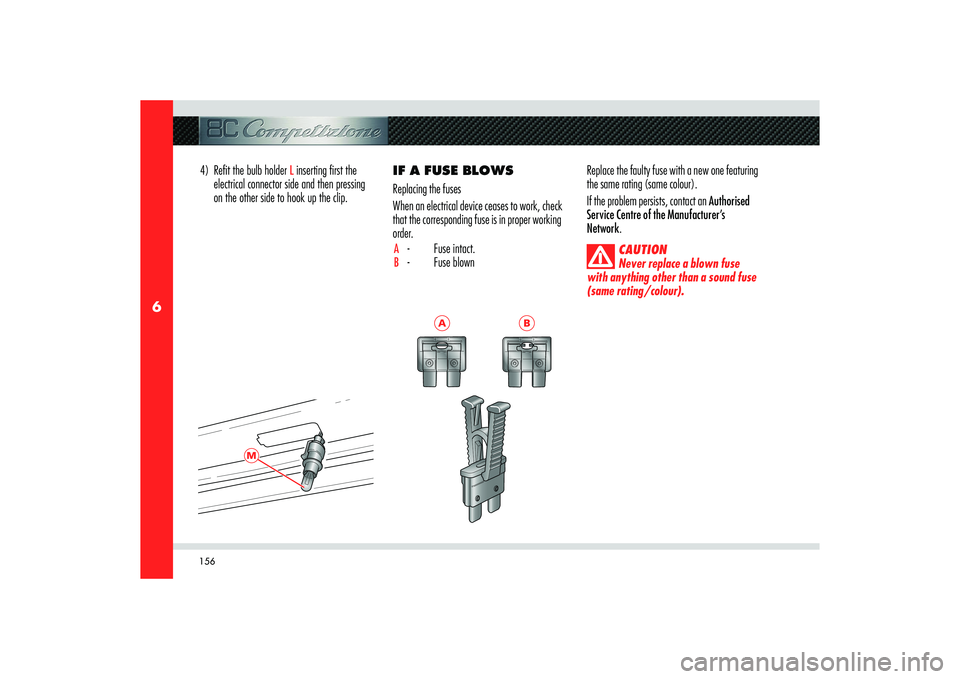
156
6
M
4) Refi t the bulb holder
L inserting fi rst the
electrical connector side and then pressing
on the other side to hook up the clip. IF A FUSE BLOWS
Replacing the fuses
When an electrical device ceases to work, check
that the corresponding fuse is in proper working
order.
A - Fuse intact.B - Fuse blownReplace the faulty fuse with a new one featuring
the same rating (same colour).
If the problem persists, contact an Authorised
Service Centre of the Manufacturer’s
Network.
CAUTION
Never replace a blown fuse
with anything other than a sound fuse
(same rating/colour).
A
B
Page 171 of 223

169
6
IN AN EMERGENCY
CAUTION
The fluid contained in the
battery is poisonous and corrosive.
Avoid contact with the skin and eyes.
The battery recharging procedure
must be carried out in a ventilated
environment away from open flames
or possible sources of sparks: risk of
explosion and fire!
IF YOU HAVE
TO JACK UP THE
VEHICLE
If you need to jack up the vehicle, position the
rubber bushings in correspondence to the arrows.